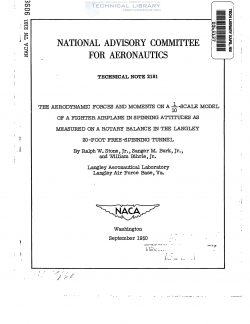naca-tn-2181
- Version
- 140 Downloads
- 2.34 MB File Size
- 1 File Count
- December 12, 2016 Create Date
- December 12, 2016 Last Updated
National Advisory Committee for Aeronautics, Technical Notes - The Aerodynamic Forces and Moments on a 1_10 Scale Model of a Fighter Airplane in Spinning Attitudes as Measured on a Rotary Balance in the Langley 20' Free Spinning Tunnel

An investigation was conducted to provide general information on
the magnitudes and directions of the aerodynamic forces and moments
exerted on a model of a fighter airplane in spinning attitudes as
measured on a rotary balance installed in the Langley 20-foot free-
spinning tunnel. The investigation included the determination of the
effect on the aerodynamic forces and moments of reversing the rudder,
of modifying the tail, and of deflecting the flaps and lowering the
landing gear. The lie-scale model was mounted on the rotary balance at
attitudes simulating spinning conditions of a previously tested $—scale
dynamic model and at other arbitrary spinning attitudes.
The results indicated that the primary effect of rudder reversal
was to give a relatively large increment of anti-spin yawing-moment
coefficient when compared with the magnitude of the aerodynamic yawing-
moment coefficient of the fully developed spin; the other force and
moment coefficients were affected to a much less degree. The increment
of yawing-moment coefficient due to rudder reversal increased with
decreasing angle of attack. Moving the horizontal“ tail rearward for this
design increased the rudder-reversal effectiveness; deflecting the
landing flaps reduced the rudder-reversal- effectiveness. A conservative
estimate from the experimental results indicates that a total aerodynamic
yawing—moment coefficient ranging from approximately 0.021 to 0.025,
against the spin, may be required for satisfactory recoveries from steep
spins. Larger values of yawing-moment coefficient may be required for
flatter spins. The aerodynamic force. and moment measurements were in
qualitative ayeement with free-spinning results as regards spin and
recovery characteristics.
The spinning and the spin recovery of airplanes have always been
subjects of concern to manufacturers and pilots. It was realized in the
past that the effects of the various components of an airplane on the
spin and spin recovery could be determined by measurements of the aero-
dynamic forces and. moments exerted on the spinning airplane. Measurements
were made, therefore, of the aerodynamic characteristics of small models
of rotating wings and airplanes by the use of an intricate spinning '
balance in the former N.A.C.A. 5-foot vertical wind tunnel.
| File | Action |
|---|---|
| naca-tn-2181 The Aerodynamic Forces and Moments on a 1_10 Scale Model of a Fighter Airplane in Spinning Attitudes as Measured on a.pdf | Download |
Comment On This Post